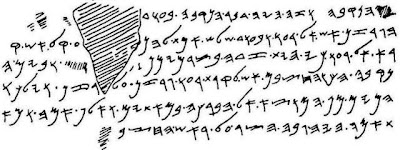
--something of interest was noticed subsequent to the time this forgery turned up. Paleo-Hebrew written on leather (or pottery) does not look like Paleo-Hebrew chiseled out of stone. With ink a cursive can develop and the thickness of the lines is influenced by the pen.
Carved in stone:

Ink on pottery:

Simply put, the real thing would have looked more like the second and less like the first. Instead, it looks exactly like the first. In the words of MH Goshen-Gottstein, " The Shapira Forgery and the Qumran Scrolls," JJS 7:3-4, 1956, "the forger imitated Paleo-Hebrew monumental letters, i.e. letters used on inscriptions (or coins). Neither he nor any scholar in the 1880s could know....that a written Paleo-Hebrew document exhibits altogether different characteristics."





No comments:
Post a Comment